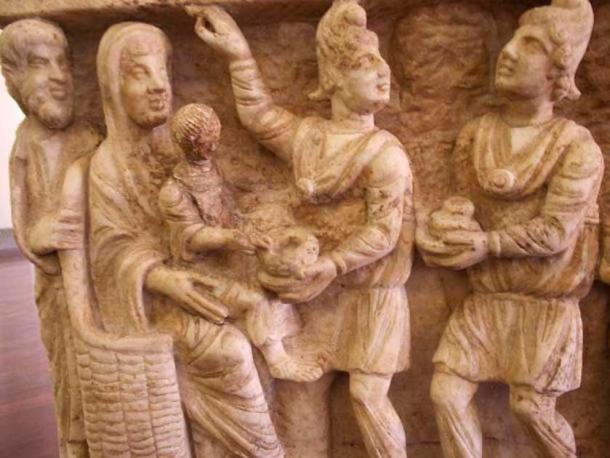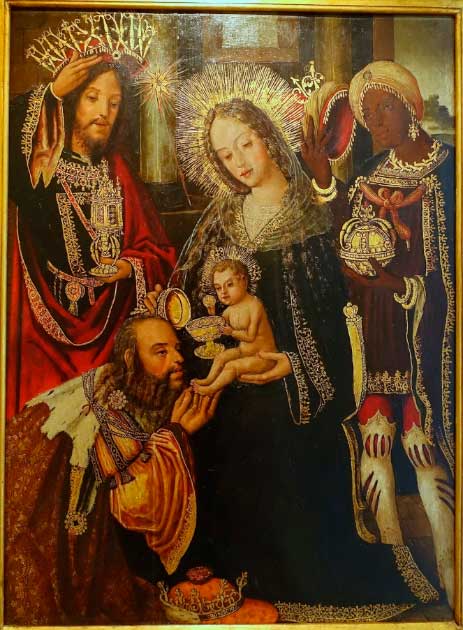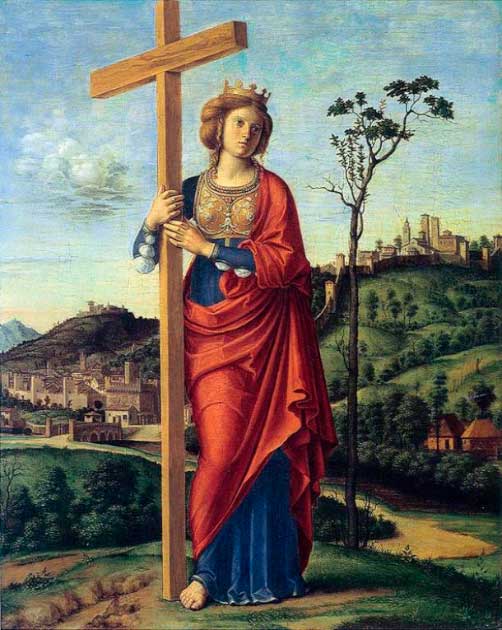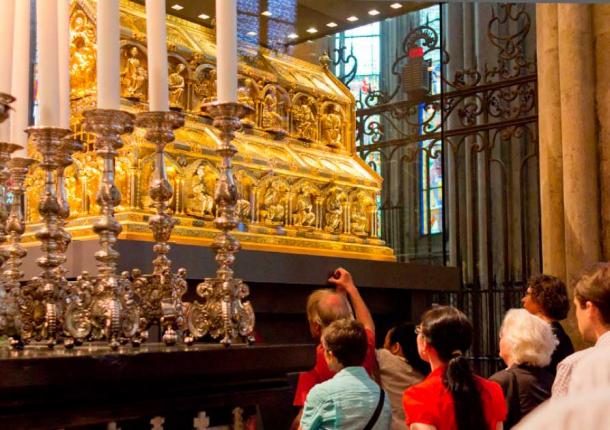
The Feast of Epiphany: Who Were The Three Kings and Where Did They Come From?
In Western Christianity, the feast of Epiphany, also known as Three Kings’ Day, is celebrated annually on the 6th January to commemorate the visit of the Magi, wise men, or kings from the East to the baby Jesus. The Three Kings are celebrated particularly in Spain and Latin American countries, a day marked by parades, meals and gift-giving, similar to how Christmas is celebrated on the 25th December in other parts of the world.
The image of three wise men from the East bringing precious gifts and paying homage to the child Jesus is linked inextricably with today’s Nativity scenes. Nevertheless, the story of the Magi’s visit is not found in all four of the canonical Gospels. Apart from the Gospel according to Matthew, the other three Gospels say nothing about these magi. So, who are the Magi, or Three Kings, who visited the infant Jesus?

3rd century sarcophagus depicting two magi bearing gifts from the Vatican Museums in Rome, Italy. (Public domain)
The Magi in Matthew’s Gospel – How Many Magi Were There?
The account in Matthew’s Gospel regarding the visitation of the Magi is as follows:
“Now when Jesus was born in Bethlehem of Judaea in the days of Herod the king, behold, there came wise men from the east to Jerusalem… When they saw the star, they rejoiced with exceeding great joy. And when they were come into the house, they saw the young child with Mary his mother, and fell down, and worshipped him: and when they had opened their treasures, they presented unto him gifts; gold, and frankincense, and myrrh.”
- Was the Magi’s Mission History or Myth?
- Frankincense: An Ancient Wonder Cure on the Verge of Extinction
Note that Matthew does not mention the exact number of these Magi from the East. According to tradition, however, there were three. It is likely that this number was chosen to correspond with the number of gifts presented to the baby Jesus – gold, frankincense, and myrrh.
Nevertheless, other numbers are provided by other traditions. In the Orient, for instance, tradition dictates that there were 12 Magi. Additionally, early Christian art provides different numbers of Magi. In a painting from the cemetery of Sts. Peter and Marcellinus, two Magi are shown. A painting in the Lateran Museum, however, shows three, whilst another in the cemetery of Domitilla shows four. On a vase in the Kircher Museum, eight Magi are shown.

Adoration of the Magi, altarpiece from the Mosteiro de Celas, by Manuel Vicente circa 1500 to 1525. (Public domain)
What Were the Wise Men’s Names?
Like the number of Magi, the names of these wise men are also unknown. Once again, it is due to tradition that we have their names. Additionally, the names given to these biblical figures differ based on tradition. In Western tradition, for instance, the three Magi were Melchior, Caspar and Balthazar. These men were said to have come from Persia, India and Babylonia respectively.
According to the Syrian tradition however, the names of the Magi are Larvandad, Hormisdas, and Gushnasaph. In the Armenian tradition, on the other hand, Kagba, Badadakharida, and Badadilma are the names of the Magi.
After the Magi had paid homage to the infant Jesus, they were prepared to return to Jerusalem, as they were requested by King Herod to bring news of the child’s whereabouts. The wise men believed Herod when he claimed that he desired to go and worship the new-born king as well. In a dream, however, the wise men were warned by God not to return to Herod, and the Magi “departed into their own country another way.”

Helena of Constantinople, who supposedly located the remains of the Three Kings, by Cima da Conegliano circa 1495. (Public domain)
The Magi and St. Helena
Thus, the story of the Magi comes to an end, or so it seems. Nevertheless, during the 4th century AD, St. Helena, the mother of the Roman emperor Constantine, embarked on a quest to locate the sacred relics of the Christian faith.
It is said that St. Helena succeeded in finding the remains of the Magi, reportedly discovered in Persia, and then brought them back to Constantinople. During the 5th century AD, the relics of the Magi were brought to Milan.

The Shrine of the Three Kings at Cologne Cathedral in Germany. (Elya / CC BY-SA 4.0)
When the city was conquered by Frederick Barbarossa, the Holy Roman Emperor in 1164, the relics were given to Rainald von Dassel, the Archbishop of Cologne. The remains of the Magi were then transferred to Cologne Cathedral, where they have remained, behind the high altar, ever since.
- Unveiling the Star of Bethlehem Amid the Celestial Tableau of Jesus’ Nativity
- Political Landscape of the Nativity of Jesus
A large gilded sarcophagus was built to house these remains. This reliquary, known as the Shrine of the Three Kings, is the largest reliquary in the Western world, and has drawn pilgrims to Cologne Cathedral since the supposed remains of the Magi arrived in the city during the 12th century.
Top image: A Byzantine depiction of the Three Wise Men (526 AD) from the Basilica of Sant' Apollinare Nuovo in Ravenna, Italy. Source: Nina-no / CC BY-SA 2.5
By Wu Mingren
References
Drum, W. 1910. Magi. Available at: http://www.newadvent.org/cathen/09527a.htm
Zavada, J. 08 October 2019. “Meet the Three Kings - Wise Men from the East” in Learn Religions. Available at: https://www.learnreligions.com/three-kings-wise-men-from-the-east-701082
2014. The Bible: Standard King James Version. Available at: http://www.kingjamesbibleonline.org/
















Comments
Goodness, Helena sure was a whiz at finding things. Hundreds of years after the events supposedly happened, even. Wish I had her around in the mornings to help me find my keys. Although the keys she’d turn up with probably wouldn’t start my car. ;)
Thank you for writing this up!
The quotation: "Creation myths always have some basis in truth" seems to keep ringing true. Although the ugly truths inherent in human sexual lasciviousness unbridled by civil law and individual personal integrity tend to have brought down many great empires over and over. Then 'sacred' descriptions of a people's 'evolution in progress' get editted to avoid provoking firey backlashes, probably because of all the deseases in the aftermath. The survivors write the revised copies, don't they?
Edit: and if you want to know the origin of all the ancient Middle Eastern religions... According to the Middle Eastern languages expert John Allegro they all go back to a Sumerian fertility cult/religion. (As you probably know the Sumerians were the first culture of farmers that established a stable urban culture). In their religion a male Heaven-god 'inpregnated' with his semen (rain and dew) a female Earth-goddes so she could bear fruit. All disclosed in John Allegro's book: The sacred mushroom and the cross. In a pdf file on the internet:
https://ahcult.files.wordpress.com/2013/01/the-sacred-mushroom-and-the-c...
Well 'unknown', here is the answer. In short: centuries before the beginning of our calendar - which calendar was created in midieval times (AD) in respect to the supposed 'date' of Jesus birth - Jewish lands were occupied by foreign powers: first Egyptians and then from the 9th or 8th century BCE the Assyrians, Babylonians, Persians, Macedonians and finally Romans. Of course the Jews were not happy with that. So the Jews thought: the only 'thing' that could free them from these powers was a messiah (who was already spoken of in the Torah). There were Jewish messianic - or in Greek 'christian' - sects who were in contact by means of visions to a 'phantom' named Isaiah and Joshua/Jehosjoea that lived in ‘outer space’ or 'higher realms', long before the beginning of our calendar. The idea was that this messiah would remove the Romans from the Jewish territory. Then - in Roman times - (St.) Paul came; he was a Jew from Anatolia with Roman citizenship which was very important to him; he collaborated with the Romans. He first was a hunter or traitor of Jewish rebels - often Messianic or 'Christian' Jews - who kept on resisting the Roman occupation and who had their bases or meeting points a.o. in the Jewish temples/synagogues. Then at some point Paul took a different approach to the jewish rebels. He claimed he had a vision of Jesus as so many others had had. But Paul claimed that Jesus had told him to start a sect himself where besides jews, gentiles could take part in as well. And he changed the the goal of the messiah from winning back actual territory to winning a spiritual ‘empire’. By doing that he more or less pacified the Jewish messianic teachings. And lo and behold: Paul's sect very fast became the most popular. As all the other leaders of the messianic sects Paul ‘knew’ Jesus only from visions - at least that’s what Paul told. Some of the other Jewish sects and apostles of these sects, joined Paul’s movement. Then in the year 69 of our calendar Paul died. A year later the Romans who by then were totally fed up with the jewish resistance, destroyed Jerusalem and the big Jewish temple there and started expelling the Jews from Jerusalem. And only after that the gospel of Marc was written; the oldest gospel of all the known gospels. And where for the first time a person named Jesus that had actually lived on earth, is mentioned. So again: AFTER the year 70 of our calendar. Before that there never was one word written about a Jesus actually living on earth. (And some scholars even say, the gospel of Marc was probably only intended as an allegorical text, not even as a historical account of something actually happening on earth.) And why did the writer of Marc put Jesus 'on earth’? He most probably did that to stand stronger than other 'Christian' sects that only knew Jesus by visions; the writer of the gospel of Marc could now claim that Jesus had tought his lessons to the Paulinian sect, face to face. And Marc did it to fix or record the teachings of Paul to have one, consistent teaching of Jesus for all the Pauline Jews that were now expelled from Jerusalem and the Jewish lands and were scattered over the Roman Empire. That is the true origin of Jesus 'Christ' walking the earth. It’s a totally fabricated story along the lines of Jewish and other popular religions of those days.
There is NO evidence, not one single word, that there ever was a Jesus as described in the gospels, that actually lived on earth. And that first gospel that puts Jesus on earth has historical errors in it, errors about Jewish life and geographical errors. And all other gospels were written AFTER the gospel of Marc, inspired by the gospel of Marc.
And finally, centuries later in 325 AD when the Christian faith got it’s final shape at the First Council of Nicaea under the leadership of Roman Emperor Constantine 1, this Christian faith was made in accordance with the interests of the Roman Empire. Or maybe even to serve the Empire (read: the Roman emperor, the senators and other members of the Roman aristocracy).
(Excuse my imperfect English.)
Pages